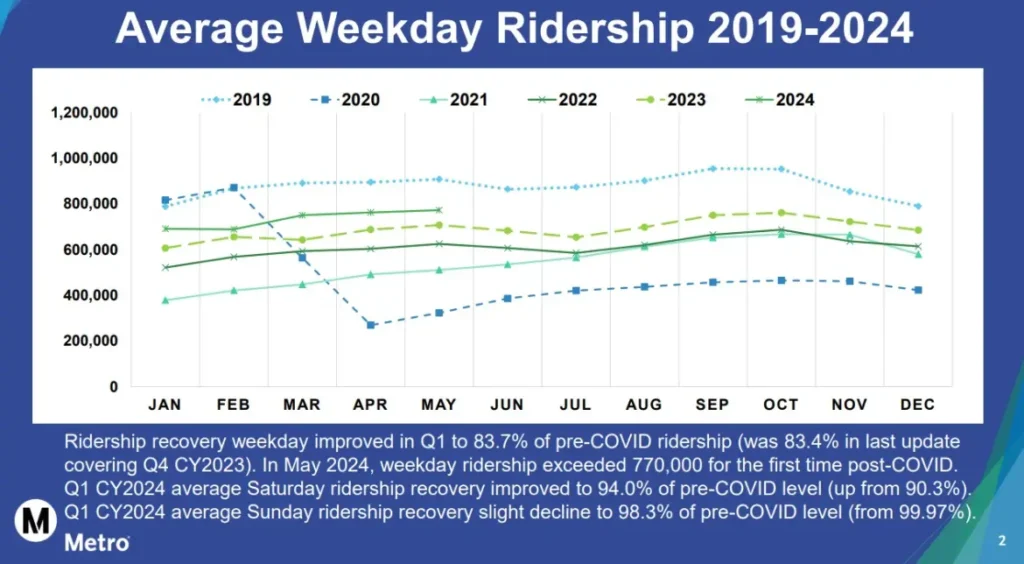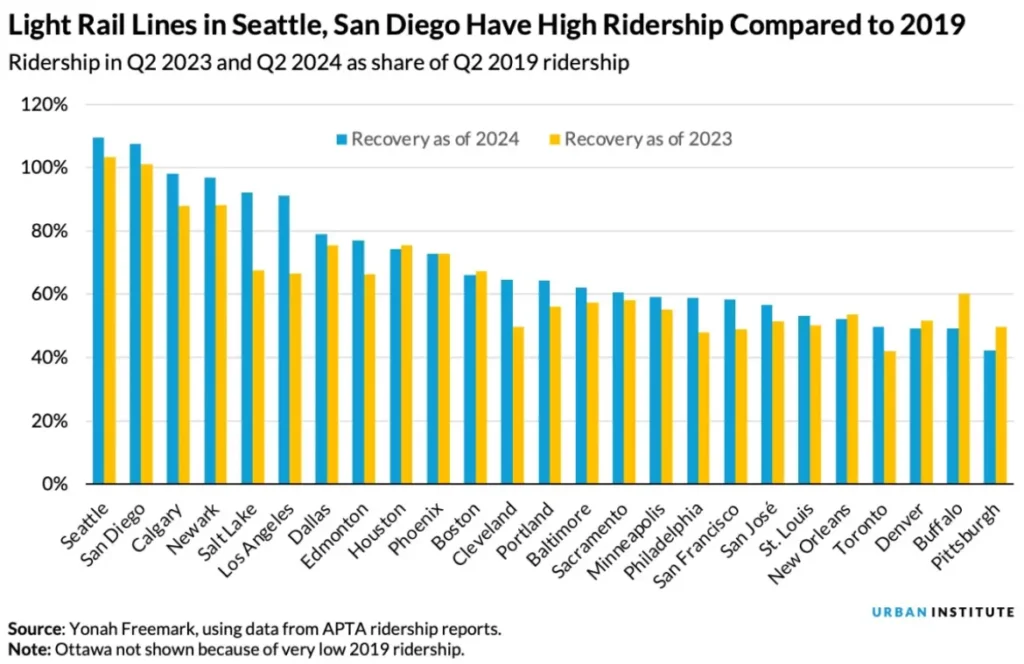This article first appeared at Streetsblog L.A. Image: Joe Linton
Metro transit ridership keeps growing. In September, weekday ridership hit a new milestone: one million average daily boardings. September also marked the twenty-second consecutive month of year-over-year ridership growth.
In a press statement, Metro CEO Stephanie Wiggins noted, “This one million-weekday-rider milestone is a testament to the enormous effort we’ve undertaken to make our system cleaner, safer, easier, more comfortable and more reliable for all the Angelenos who rely on us every day.”
First, a brief look back at what led to this. Metro cut transit service at the start of the pandemic. After false starts and an operator pay raise, Metro fully restored bus service in December 2022, then reduced excess bus cancellations which are now largely under control (though service remains slightly less reliable than pre-COVID). Since Spring 2023, Metro has operated bus service essentially at pre-pandemic levels. Metro increased heavy rail service and light rail service in September and December 2023, respectively.
That enormous service restoration effort is paying off: for two years ridership increased steadily.

Bus and rail ridership differed quite a bit during the early pandemic years. Bus ridership (nearly 80 percent of Metro ridership) dropped less, and returned more quickly, compared to rail. Metro restored full bus service sooner than rail. September saw 804,279 weekday daily bus boardings (84 percent of pre-pandemic) and 219,120 weekday rail boardings (81 percent). Factoring in strong weekends, overall bus recovery is at 86.8 percent and rail at 85.1 percent.
Light rail ridership recovery has been stronger than heavy rail. For September Metro notes that ridership is up significantly on all of its light rail lines (year-over-year comparing September 2024 to 2023):
- A Line up 16.2 percent
- C Line up 10.7 percent
- E Line up 18 percent
- K Line up 4.1 percent.
Then there’s heavy rail. For a few reasons (likely some combination of changing commutes with more work from home, Regional Connector shifts, crime, homelessness), Metro’s B/D Red/Purple Line heavy rail subway ridership still lags behind other L.A. transit. As of September, the B/D subway ridership is at 54 percent of 2019 levels (and has hovered around 50-60 percent recovery for the past 2-3 years). Today the subway sees about 70,000 daily boardings. That’s more riders than any other individual Metro rail or bus line – but it’s well below pre-pandemic years when it typically carried 130,000+.
Even with heavy rail ridership slow to recover, the overall system ridership picture is very positive.
Metro CEO Stephanie Wiggins noted, “Metro is recovering faster than almost any large transit agency in America.” Metro’s 86.4 percent recovery compares favorably to the nationwide transit ridership average of 76 percent of pre-pandemic levels. Nationally ridership continues to rebound, but many systems have struggled to restore service and reliability.

Los Angeles Metro is definitely well above average, though a few somewhat smaller systems (notably Seattle and San Diego) are doing even better.
Metro ridership growth is on target to fully recover to pre-pandemic levels in the next year or so. That’s great, albeit not quite as quick as hopeful earlier predictions from SBLA and CEO Wiggins. Metro ridership should get a boost from new bus-only lanes, bus lane camera enforcement, all-door boarding, and extended rail (K Line, A Line, and D Line) – all coming soon.
For more information on Metro’s ridership growth, see earlier SBLA coverage:
- September 2024: August Boardings set Pandemic-Era Weekend Records
- July 2024: June was 19th Consecutive Month of Year-Over-Year Ridership Increases
- June 2024: April and May were Metro’s Highest COVID Era Ridership Months
- January 2024: Metro Has Seen Steady Transit Ridership Growth for Just Over a Full Year
- December 2023: Metro Touts Full Year of Transit Ridership Growth
- November 2023: October Metro Transit Ridership Hit Another Pandemic-Era High
- September 2023: August Metro Ridership sets Four-Year High
- February 2023: Transit Ridership Gradually Increasing After Metro Restored Service
